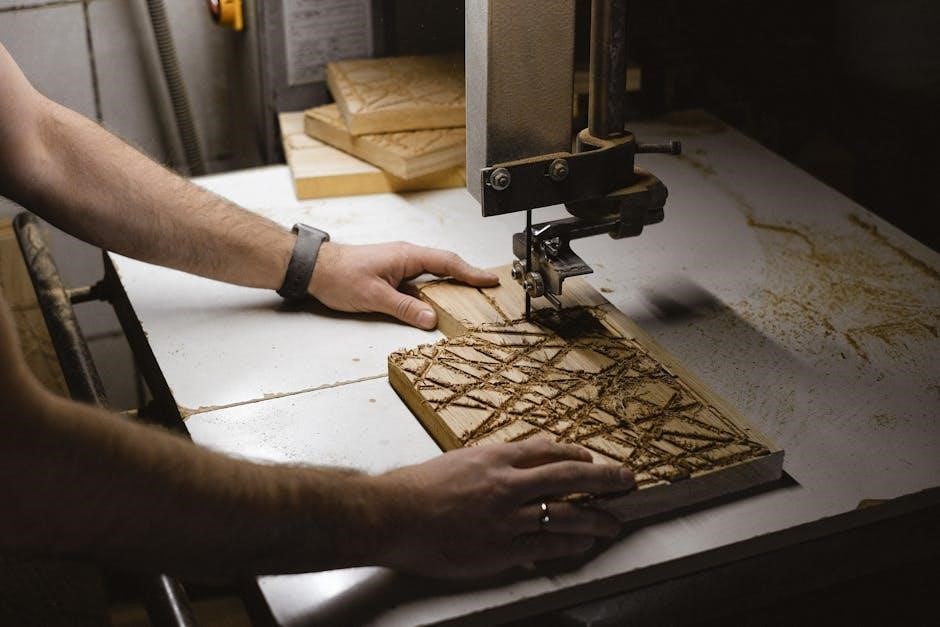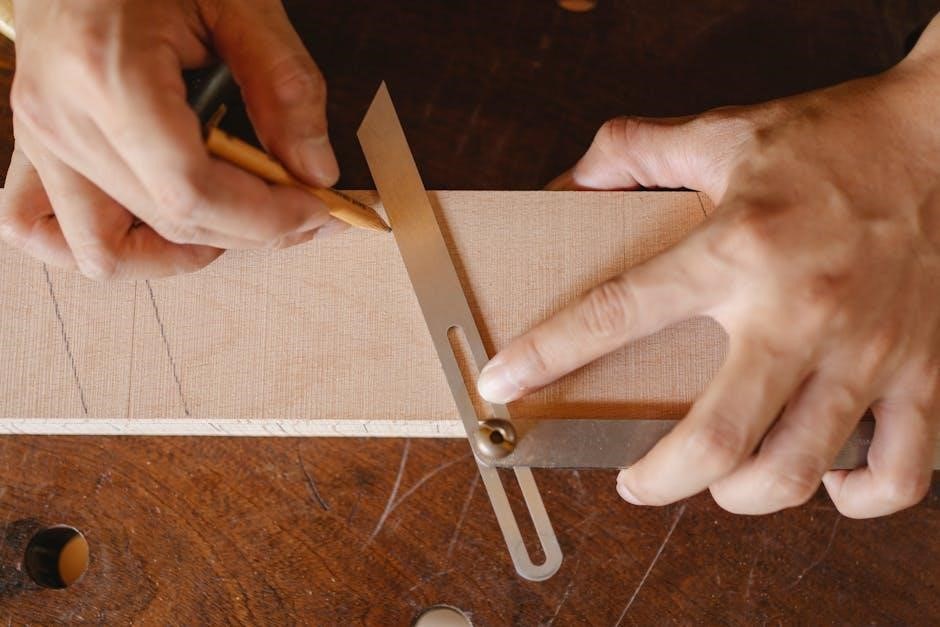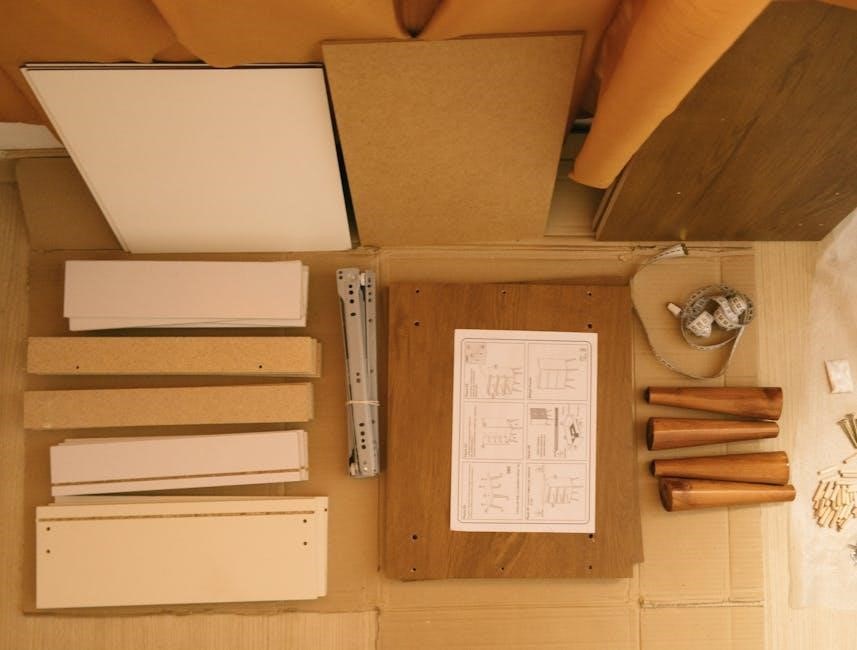The Line 6 POD Go is a powerful‚ portable multi-effects processor designed for guitarists‚ offering a wide range of amp models‚ effects‚ and cab simulations. It features a user-friendly interface‚ customizable presets‚ and seamless integration with recording software. With regular firmware updates‚ the POD Go continues to evolve‚ adding new features and amps to enhance its versatility for both live performance and studio use.
1.1 Overview
The Line 6 POD Go is a versatile and compact multi-effects processor designed for guitarists‚ offering a comprehensive suite of tools for shaping tone. It features a wide range of amp models‚ cab simulations‚ and effects‚ including a Wah block‚ Volume pedal‚ and Preset EQ. The device supports up to four additional effects blocks‚ providing flexibility for customizing sounds. With its intuitive interface‚ the POD Go allows seamless navigation between Preset and Stomp modes‚ making it ideal for both live performances and studio recording. Regular firmware updates ensure continuous improvement‚ adding new features and amps to enhance its capabilities. The POD Go is a powerful yet portable solution for guitarists seeking high-quality tones with ease of use.
1.2 Key Features
The Line 6 POD Go is equipped with a wide range of features that make it a versatile tool for guitarists. It supports one amp/preamp block‚ one cab/IR block‚ a Wah block‚ a Volume pedal block‚ a Preset EQ block‚ and an FX Loop block‚ along with up to four additional effects blocks. This allows for extensive customization of tones and effects. The device also features USB connectivity for direct recording to a computer and MIDI integration for external control. Regular firmware updates enhance its capabilities‚ such as the addition of new amps and effects. With its compact design and intuitive interface‚ the POD Go is ideal for both live performance and studio use‚ offering a powerful yet portable solution for achieving high-quality guitar tones.
1.3 Target Audience
The Line 6 POD Go is designed for a broad range of guitarists‚ from professional musicians to hobbyists. It appeals to those seeking versatile‚ high-quality tones in a portable format. Studio musicians will appreciate its USB connectivity for direct recording‚ while live performers benefit from its compact design and intuitive interface. The POD Go is also ideal for guitarists who want to explore a variety of amp models and effects without the need for multiple pedals or amplifiers. Additionally‚ its ease of use makes it accessible to beginners‚ while advanced features like firmware updates and MIDI integration cater to experienced players looking to expand their sonic possibilities. Whether for practice‚ recording‚ or live performances‚ the POD Go is a versatile tool for guitarists of all levels and genres.

Hardware Components of POD Go
The POD Go features a robust hardware design with essential components‚ including a front panel for intuitive control‚ rear connectivity options‚ and durable footswitches. Its compact build houses powerful processing capabilities‚ ensuring reliable performance for both live and studio use.
2.1 Front Panel Layout
The POD Go’s front panel is designed for intuitive navigation‚ featuring a color LCD screen for preset selection and parameter adjustment. Dedicated knobs control amp‚ cab‚ and effects settings‚ while the preset and stomp buttons provide quick access to sounds and effects. An expression pedal enables real-time control over volume‚ wah‚ or other parameters. LED indicators clearly show the active mode‚ ensuring seamless performance. The layout is user-friendly‚ allowing guitarists to focus on their playing without unnecessary complexity. This design ensures easy navigation during live performances and studio sessions‚ making the POD Go a versatile tool for musicians seeking professional tones with minimal effort.
2.2 Rear Panel Connectivity
The rear panel of the Line 6 POD Go offers comprehensive connectivity options to integrate seamlessly with your rig. The Guitar In allows direct connection of your instrument‚ while the Main Out provides a balanced XLR output for connecting to mixers or PA systems; An Amp Out is available for integrating with external amplifiers‚ and a dedicated Effects Loop enables the use of external pedals or effects processors. Additionally‚ the Variax Input supports Line 6 Variax guitars for enhanced modeling capabilities. A Headphone Out is included for silent practice‚ and a USB port allows for firmware updates and recording directly to your computer. The rear panel also features an AC Power In for connecting the included power supply. These versatile connectivity options make the POD Go adaptable to various playing scenarios‚ from live performances to studio recording sessions.
2.3 Footswitches and LED Indicators
The Line 6 POD Go features four footswitches with corresponding LED indicators‚ designed for intuitive control during performances. Each footswitch corresponds to a specific function in Stomp Mode‚ allowing you to activate or bypass individual effects blocks. The LED indicators provide clear visual feedback: green indicates an active effect‚ amber signals a bypassed effect‚ and red highlights the currently selected block. Additionally‚ the footswitches can be customized to perform various actions‚ such as toggling effects‚ accessing the effects loop‚ or navigating through presets. The LEDs also flash during preset changes to confirm the transition. This user-friendly design ensures seamless live performances‚ enabling quick adjustments and minimizing distractions. The footswitches and LEDs work together to enhance your playing experience‚ offering both functionality and visual confirmation of your settings.

Getting Started with POD Go
Transition from unboxing to playing with ease. Learn initial setup steps‚ explore essential features‚ and customize tones for live performance and recording. Start your musical journey seamlessly.
3.1 Unboxing and Initial Setup
When you unbox the POD Go‚ you’ll find the unit‚ a power supply‚ a USB cable‚ and a footswitch. Inspect all components for damage and ensure everything is included. Place the POD Go on a flat‚ stable surface‚ away from direct sunlight. Connect the power supply to the DC IN jack on the rear panel and plug it into a power outlet. The LED indicator will light up‚ confirming the unit is powered on. Before first use‚ download and install the latest firmware via the Line 6 Updater app to ensure optimal performance. Familiarize yourself with the LCD interface and navigation buttons. This initial setup prepares you to explore the POD Go’s full capabilities‚ ensuring a smooth and intuitive experience from the start.
3.2 Connecting Instruments and Outputs
To connect your instrument‚ plug your guitar or other instrument into the Guitar In jack on the front panel using a standard 1/4-inch guitar cable. For alternate instruments‚ use the Alternate Instrument input. Ensure the cable is securely connected to both the POD Go and your instrument. For outputs‚ the POD Go offers flexible options. Use the 1/4-inch Outputs for connecting to an amplifier‚ mixer‚ or direct injection box. For studio or live sound‚ utilize the XLR Outputs‚ which provide a balanced signal. The Headphone Jack allows for silent practice or personal monitoring. Additionally‚ connect the POD Go to your computer via USB for recording or editing with the Line 6 app. Always use high-quality cables to maintain sound integrity and ensure proper connectivity for optimal performance.
3.3 Powering On and Basic Functionality
Power on the POD Go by plugging it into a power source using the included power supply and pressing the power button. The device will boot up‚ and the LCD screen will display the home screen. Familiarize yourself with the basic controls‚ including the navigation buttons‚ preset knob‚ and footswitches. Use the Home button to access the preset browser‚ where you can select and manage tones. The Nav buttons allow you to scroll through menus‚ while the Knob adjusts parameters. LED indicators will light up to show active functions‚ such as preset selection or effect engagement. Experiment with footswitches to toggle effects or switch between presets. Adjust the Master Volume knob to set your output level. Powering on and navigating the POD Go is straightforward‚ making it easy to start creating and playing right away. The intuitive design ensures a seamless experience for both beginners and professionals.

Navigation and Preset Management
The POD Go features a user-friendly interface with an LCD screen and navigation buttons for easy Tone organization. Use the Home button to access the preset browser‚ while the Nav buttons scroll through menus. The Knob adjusts parameters‚ and LED indicators provide visual feedback. Presets are organized into categories‚ making it simple to browse and select tones. Quickly access favorite sounds using the Quick Access feature. The intuitive design allows seamless navigation and management of tones‚ ensuring efficient workflow for both live performance and studio use.
4.1 Understanding Preset Mode
Preset Mode on the Line 6 POD Go allows seamless browsing and selection of tones. Press the Home button to enter Preset Mode‚ where you can navigate through categories and individual presets. Use the Nav buttons to scroll through the list‚ and the Knob to select a preset. The LCD screen displays preset names and categories‚ simplifying tone selection. Presets are organized into folders like Factory Presets and My Presets‚ with up to 128 slots per category. Once a preset is selected‚ press the Home button again to exit. LED indicators confirm preset selection. This mode is ideal for live performances and quick tone changes‚ ensuring intuitive access to your favorite sounds. Preset Mode streamlines workflow‚ making it easy to organize and recall tones during gigs or recording sessions.
4.2 Navigating Stomp Mode
Stomp Mode on the Line 6 POD Go allows real-time control of effects and tone customization. Access Stomp Mode by pressing the Home button until the display shows the active preset’s effects layout. Use the footswitches to enable or bypass individual effects blocks‚ with LED indicators showing their status. The LCD screen displays the effects chain‚ and you can scroll through blocks using the Nav buttons. Pressing a footswitch toggles the corresponding effect on or off‚ while holding it selects the block for parameter adjustment. The Knob allows fine-tuning of effect settings. Stomp Mode mimics a traditional pedalboard experience‚ offering hands-on control for live performances or studio tweaking. This mode enhances creativity by allowing dynamic tone adjustments without deep menu diving.
4.3 Browsing and Selecting Presets
Browsing and selecting presets on the Line 6 POD Go is intuitive‚ allowing quick access to tones. Press the Home button to enter the preset browser‚ then use the Nav buttons to scroll through categories like Amp Models‚ Artist Presets‚ or User Presets. Highlight a preset using the Nav buttons and press Select to load it. The LCD screen displays preset names for easy identification. Use the Knob to scroll through long lists. To save a preset‚ press and hold Select to access the save menu. Favorites can be marked for quick access by holding the Footswitches during preset selection. This streamlined interface ensures efficient preset management‚ making it easy to find and load the perfect tone for any session.

Tone Shaping with POD Go
The POD Go offers unparalleled flexibility for shaping your tone‚ with intuitive controls and customizable options to craft your unique sound. Explore a wide range of tonal possibilities with user-friendly tools designed to enhance your playing experience.
5.1 Configuring Amp/Preamp Block
The Amp/Preamp Block in the Line 6 POD Go is essential for shaping your core tone. It offers a variety of amp models‚ from clean to high-gain‚ allowing you to select the perfect base tone for your music. To configure this block‚ start by selecting an amp model from the extensive library. Adjust the “Drive” knob to set the desired level of gain‚ whether you prefer a clean sound or a heavily distorted one. Fine-tune the “Bass‚” “Mid‚” and “Treble” controls to sculpt your tone precisely. Additionally‚ the “Sag” and “Hum” settings provide realistic amp behavior‚ simulating the dynamics of a real amplifier. Experiment with these settings to achieve a sound that matches your musical style and preferences.
5.2 Setting Up Cab/IR Block
The Cab/IR Block in the Line 6 POD Go allows you to customize your tone with cabinet simulations and impulse responses (IRs). To set this up‚ press the “Amp” button to cycle to the Cab/IR Block. From there‚ you can select from a variety of cabinet models‚ each designed to match popular guitar cabs. Additionally‚ you can choose from different microphone types and placements to refine your sound. For even more flexibility‚ the POD Go supports third-party IRs‚ which can be loaded via the Line 6 Updater. Daisy-chaining multiple Cab/IR Blocks enables you to blend tones for unique textures. Adjust the “Level” and “Mic Position” knobs to fine-tune the cabinet’s response. Experiment with these settings to find the perfect balance for your tone. The Cab/IR Block is a powerful tool for achieving professional-sounding results‚ whether you’re playing live or recording.
5.3 Adjusting Preset EQ
Adjusting the preset EQ on the Line 6 POD Go allows you to fine-tune your tone by shaping the frequency response of your sound; To access the EQ‚ press the “Edit” button and navigate to the EQ block in your preset. The POD Go offers multiple EQ types‚ including parametric‚ graphic‚ and wah‚ each with unique controls. For parametric EQ‚ adjust the frequency‚ gain‚ and Q (bandwidth) knobs to target specific tones. Graphic EQ provides a visual representation‚ letting you boost or cut predefined frequencies. Use the “Low Cut” and “High Cut” switches to remove unwanted low or high frequencies. Subtle adjustments can make a significant difference in clarity and balance. Experiment with these settings to carve out space in a mix or enhance specific characteristics of your sound. Saving your customized EQ settings ensures consistency across performances and recordings.

Effects and Processing
The POD Go offers a wide range of built-in effects‚ including reverb‚ delay‚ distortion‚ and modulation. These effects can be easily customized to create unique tones and enhance your sound.
6.1 Overview of Built-in Effects

The Line 6 POD Go is equipped with a comprehensive suite of built-in effects‚ catering to a wide range of musical genres and playing styles. Users can access a variety of effects categories‚ including distortions‚ modulations‚ delays‚ and reverbs‚ all meticulously designed to deliver high-quality tones. The device features popular effects such as overdrive‚ chorus‚ flanger‚ phaser‚ and plate reverb‚ ensuring versatility for both studio and live performances. These effects can be easily combined and customized to create complex‚ layered sounds. With its intuitive interface‚ the POD Go allows seamless navigation through effects options‚ enabling quick adjustments and real-time tweaking. The built-in effects are also fully assignable to footswitches‚ making it easy to engage or bypass them during performances. This flexibility and depth of effects processing make the POD Go a powerful tool for guitarists seeking to expand their sonic possibilities.
6.2 Using Modulation Effects
The Line 6 POD Go offers an extensive range of modulation effects‚ including chorus‚ flanger‚ phaser‚ and tremolo‚ to add depth and movement to your sound. These effects can be easily accessed and adjusted via the device’s intuitive interface. To use modulation effects‚ navigate to the effects section and select the desired type. Key parameters such as speed‚ depth‚ and feedback can be tweaked to tailor the effect to your preference. The POD Go also allows for real-time control of modulation effects using footswitches‚ enabling dynamic adjustments during performances. Additionally‚ modulation effects can be placed at various points in the signal chain‚ either before or after the amp‚ to achieve the desired tonal impact. Experimenting with different modulation settings can help create unique and engaging sounds‚ making the POD Go a versatile tool for musicians seeking to enhance their tonal palette.

6.3 Effective Use of Wah Block
The Wah Block on the Line 6 POD Go is a powerful tool for adding dynamic‚ expressive tones to your playing. This effect mimics the classic wah-wah pedal sound‚ offering a range of tonal possibilities. To use the Wah Block effectively‚ assign it to a footswitch for real-time control‚ allowing you to sweep the frequency range with your foot. The POD Go also includes options like Auto Wah‚ which automatically applies the effect based on your playing dynamics. Adjusting parameters such as Frequency‚ Resonance‚ and Range can tailor the Wah effect to your sound. For added versatility‚ you can assign the Wah to an expression pedal for smooth‚ manual control. Experimenting with different Wah settings can enhance solos‚ rhythm parts‚ and even bass lines‚ making it a valuable addition to your tonal arsenal.

Connectivity and Integration
The Line 6 POD Go offers robust connectivity options‚ including USB for recording‚ MIDI for external control‚ and compatibility with Line 6 products like the Relay series.
7.1 USB Connectivity for Recording
The Line 6 POD Go features a USB 2.0 interface for seamless recording and integration with your computer. This allows you to record high-quality audio directly into your DAW. The USB interface is driverless‚ ensuring easy setup across Windows and macOS systems. You can record both processed tones and dry signals‚ giving you flexibility in post-production. The POD Go also supports reamping‚ enabling you to send processed sounds back to your DAW for further tweaking. Additionally‚ the USB connection provides a MIDI interface‚ allowing you to control virtual effects or sync with other MIDI devices. With its low-latency performance‚ the POD Go is ideal for studio and home recording environments. Ensure your firmware is up-to-date for optimal USB functionality and compatibility with your recording software.
7.2 MIDI Integration for Control
The Line 6 POD Go supports MIDI integration‚ allowing advanced control over its functions via MIDI-compatible devices. The rear panel features MIDI In and Out ports‚ enabling seamless communication with external controllers‚ pedals‚ or other MIDI-equipped gear. This functionality is ideal for live performances‚ where you can switch presets‚ toggle effects‚ or adjust parameters using a MIDI foot controller. Additionally‚ the POD Go can send MIDI signals to control other devices‚ creating a unified setup. MIDI clock sync is also supported‚ ensuring synchronization with drum machines or sequencers. Assigning MIDI commands to specific functions within the POD Go is straightforward‚ offering customization for your workflow. This feature enhances both live and studio applications‚ providing greater flexibility and control over your sound and performance.
7.3 Compatibility with Line 6 Products
The Line 6 POD Go is designed to integrate seamlessly with other Line 6 products‚ enhancing your workflow and creative potential. It is fully compatible with the Helix family of products‚ allowing for easy preset sharing and tone matching. Additionally‚ it works hand-in-hand with the HX Stomp‚ enabling a compact yet powerful rig. The POD Go also supports integration with Line 6’s Relay G10 wireless systems‚ offering a cable-free guitar experience without compromising tone. This compatibility ensures a cohesive ecosystem for both live performance and studio recording. Whether you’re using multiple Line 6 devices or pairing the POD Go with external gear‚ its versatility and seamless integration make it a central hub for your musical setup. This compatibility allows you to focus on your music while enjoying a streamlined and efficient workflow.

Firmware and Maintenance
Regular firmware updates ensure optimal performance‚ add new features‚ and fix bugs. Proper maintenance‚ like cleaning and updating software‚ keeps your POD Go functioning at its best.
8.1 Checking Current Firmware Version
To ensure optimal performance‚ it’s essential to verify the firmware version on your POD Go. Start by powering on the unit and navigating to the Menu using the Home and Navigation buttons. Scroll to System and press Enter. Select Firmware from the list to display the current version installed. Additionally‚ you can use the Line 6 Updater app on your computer to check for updates and verify the firmware version. This ensures your device is running the latest software‚ providing access to new features‚ bug fixes‚ and improved functionality. Regular checks help maintain your POD Go’s performance and compatibility with other Line 6 products. Always refer to the official Line 6 website for the most accurate and up-to-date firmware information.
8.2 Updating Firmware via Line 6 Updater
Updating the firmware on your POD Go is straightforward using the Line 6 Updater application. First‚ connect your POD Go to your computer via USB. Download and install the Line 6 Updater from the official Line 6 website. Launch the updater‚ and it will automatically detect your POD Go. Follow the on-screen instructions to check for available updates. If an update is found‚ select the firmware version and proceed with the download. Once the update is complete‚ the POD Go will restart automatically. Ensure the device remains connected and powered on throughout the process. Do not disconnect or power off the unit‚ as this could cause system instability. After the update‚ verify the firmware version under the System menu to confirm successful installation. Regular updates ensure you have the latest features‚ improvements‚ and bug fixes for optimal performance.
8.3 Troubleshooting Firmware Issues
If you encounter issues after updating or installing firmware‚ start by powering off the POD Go‚ unplugging it‚ and waiting 30 seconds before reconnecting and restarting. This basic reset often resolves minor glitches. Ensure your POD Go is running the latest firmware by checking the version in the System menu. If the device fails to power on or freezes‚ ensure the USB connection is secure and try a different USB port or cable. If the POD Go isn’t recognized by the Line 6 Updater‚ reinstall the application and restart your computer. For persistent problems‚ perform a factory reset by holding the Home and Back buttons while powering on. This will restore default settings but won’t erase custom presets. If issues persist‚ contact Line 6 support for further assistance. Always back up custom presets before performing any troubleshooting steps.

No Responses